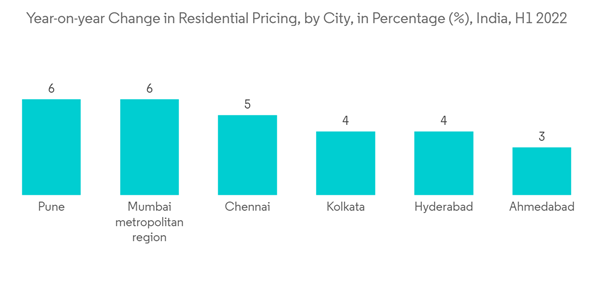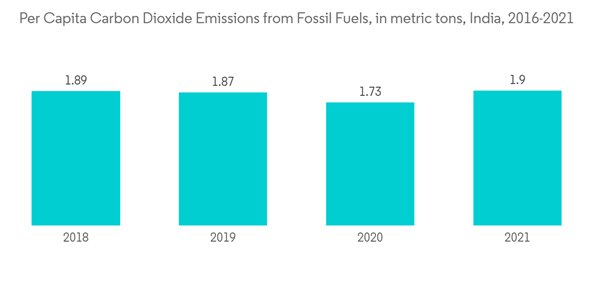Key Highlights
- Supply chain issues related to the Covid-19 pandemic have made it difficult to buy a home at affordable prices. Thus, more people may start turning to manufactured homes to achieve the dream of homeownership. As housing costs increase due to lumber price spikes and concrete shortages, many homeowners may favor manufactured homes, leading to market growth.
- Owing to the lengthy construction time for conventional brick-and-mortar structures and growing awareness about environmental concerns, many people nowadays prefer building prefab homes over traditional houses. However, in India, prefab homes are still at a very nascent stage. People are skeptical about prefab homes, mainly because there is a lot of misinformation about how these homes are built and their benefits. Still, prefab homes are slowly growing in the Indian construction space.
- The demand for prefabs has increased in the last few years due to reasons like hassles in civil construction, timis took in concrete buildings, no time for supervision, and the adoption of new and better technologies. The response is really good for high-end farmhouses and cottages for resorts and hotels, but it will still take time for the people of India to accept prefab as their main home for living permanently.
- A few builders are coming up with mobile houses which can be ideally placed at guesthouses, farmhouses, es and near agriculture fields for the people to enjoy their weekends with friends and relatives. The concept of mobile houses was popular in European countries where people call them tiny houses. A trend is emerging in Hyderabad, India for such houses. According to Mobile House, a real estate firm in Hyderabad, these kinds of shelters can be built in a space starting from 300 to 1,000 sqft depending on the availability of land.
- According to the firm, there is a good demand for mobile houses in Hyderabad and it has already sold 200 units, which can be seen near Shankarpally and Yadagirigutta. Since prefab structures fall under the ‘temporary construction’ category, the rules around them in India are few and scattered. The permissions change in each Indian state and one rule can and is applied to such homes. As more people in the country become aware of this concept, it is estimated that the manufactured home trend picks up and becomes a viable solution for those looking to build a sturdy home in a limited time and budget.
India Manufactured Homes Market Trends
Affordability of Manufactured Homes May Drive the Market Growth
Housing prices across the top eight cities of India, namely Delhi-NCR, MMR, Kolkata, Pune, Hyderabad, Chennai, Bengaluru, and Ahmedabad, continue to grow at 6% year-on-year during July-September of 2022. Since the beginning of 2022, housing prices had been on the rise on the back of increased demand seen since 2021, paired with a rise in input prices. The cost of key materials like cement and steel has risen over 20% yearly as of March 2022. These constitute a predominant share of the total cost of construction. So far, developers were cautious about increasing prices as the market was recovering from the aftermath of Covid-19.However, developers are now feeling the negative effects. The cost of construction has increased by 28% as on November 2022, higher than pre-pandemic levels. The costs of key construction materials had jumped 32% in a span of three years since 2020. Such an environment is not so favorable for new home buyers. Thus, they may start looking for alternatives.
Manufactured homes cost less because they are mass-produced and built on assembly lines, Manufactured homes are much more affordable than traditional homes. According to the Manufactured Housing Institute, manufactured housing costs about half of what a traditional house costs on a square-foot basis. The total cost of manufactured homes is around USD 100-200 per square foot; in contrast, a traditional new-build home averages USD 150 per square foot, and can easily go as high as USD 400, depending on the locality. Also, a modular home may be more expensive than a comparable manufactured one.
The average cost of a 2,000-square-foot modular home runs about USD 240,000. A comparable manufactured home costs about USD 150,000-170,000. Customers can end up saving hundreds of thousands of dollars by buying a manufactured home as opposed to a traditional home. Consequently, with the rising construction costs the demand in the manufactured homes market may also rise.
Carbon Emissions Targets Can Boost the Demand in the Market
Global warming is increasing rapidly and the fourth biggest carbon emitter in the world is India. GHGs are the major pollutant in the environment and the construction industry is considered 19% responsible for it. Around 40% of the carbon footprint is generated by construction and buildings together due to various processes like lighting, cooling, and heating of building materials.By the year 2050, the carbon emissions from buildings are set to aim at zero as per the world resources Institute paper Paris Agreement. But as per today's scenario, there is not even 1% of the total buildings that can help in achieving the target of zero. India wants to reduce up to 1 billion tons of total projected carbon emissions by 2030 and a 45% reduction of carbon intensity by 2030 over 2005 levels. Manufactured homes could play a major role in this regard.
Companies that build manufactured homes generate up to 90% less waste than traditionally built homes, according to the Manufactured Home Institute. Transporting and assembling a manufactured home on-site causes significantly less environmental damage than the process of building a traditional home. Additionally, because of the effective development process, there is less wastage when building a manufactured home and the scraps are often reused. Besides a more environmentally friendly construction or design, the materials that are now used to build manufactured homes are selected for their energy efficiency.
A prime example is comprehensive insulation to reduce heat loss and heating fuel energy usage. By adding environmentally friendly/safe insulation to a manufactured home’s underside, walls, and roof alone, the overall homes’ energy use decreases up to 31%. Due to less energy usage and reduced environmental damage manufactured homes may see increased adoption in the coming years.
India Manufactured Homes Industry Overview
The India manufactured homes market is fragmented in nature considering the presence of several players in the market, with the major players not holding significant market share. Epack Prefab, Shadecrafts India, Magic Structures, Windoors International Ltd., and Karmod Prefabricated Technologies are some of the major players in the market.Additional Benefits:
- The market estimate (ME) sheet in Excel format
- 3 months of analyst support
This product will be delivered within 2 business days.
Table of Contents
Companies Mentioned (Partial List)
A selection of companies mentioned in this report includes, but is not limited to:
- Epack Prefab
- Loom Crafts
- Shadecrafts India
- Magic Structures
- Windoors International Ltd.
- Pressmach Infrastructure Private Limited
- Multi Decor India Pvt. Ltd
- Satec Envir Engineering
- Karmod Prefabricated Technologies
- Okno Modhomes
- Nest-in*
Methodology

LOADING...










